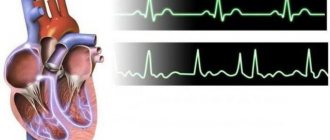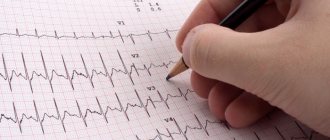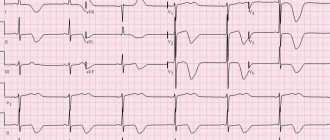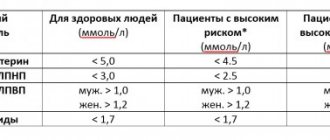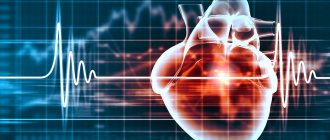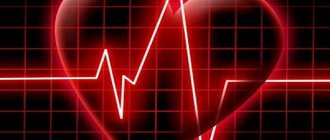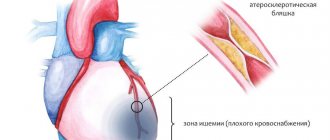Myocardial infarction is a focus of necrosis of the heart muscle that develops against the background of an acute circulatory disorder in the coronary arteries.
If we talk about myocardial lesions in general, infarction is the most common pathology. This condition is a direct indication for hospitalization of the patient in a specialized department, since without the provision of qualified medical care it can lead to death. Considering the danger of pathology, it is better to prevent it than to treat it. That is why, if you suspect coronary heart disease (CHD) or other disorders of the heart, it is important to immediately seek help from a specialist in order to prevent the formation of a disease such as myocardial infarction.
Causes
To understand what a heart attack is, it is extremely important to understand the reasons that cause it. One of the most important reasons against which this condition develops can be confidently called atherosclerosis. This is a disease whose pathogenetic basis is a violation of fat metabolism in the body.
Against the background of excess cholesterol and lipoproteins, they are deposited in the lumen of blood vessels with the formation of characteristic plaques. In case of blockage of the coronary arteries, a heart attack occurs. In more detail, there are three main components of atherosclerosis, which can cause circulatory disorders in the coronary arteries, namely:
- Narrowing of the lumen of blood vessels as a result of the deposition of plaques on their walls. This also leads to a decrease in the elasticity of the vascular wall.
- Vasospasm, which can occur due to severe stress. In the presence of plaques, this can lead to acute coronary circulatory disorders.
- Separation of plaque from the vascular walls can cause arterial thrombosis and, worse, myocardial infarction (damage).
Thus, atherosclerosis is the main cause of myocardial infarction, which is a rather dangerous condition and must be corrected.
The risk of developing a disease such as a heart attack is significantly increased by the following factors:
- Bad heredity. Pathologies of the cardiovascular system in close relatives play a role.
- Poor nutrition and sedentary lifestyle. These factors lead to the formation of a condition such as obesity in a person.
- Obesity. Excess fat leads to direct deposition of plaques on the walls of blood vessels.
- Bad habits. Drinking alcohol and smoking lead to vasospasm.
- Endocrine disorders. Patients with diabetes are more prone to changes in cardiac circulation. This is due to the negative effect of this disease on blood vessels.
- A history of heart attacks.
Blood pressure disorders, manifested by persistent hypertension, and constant stress can also cause a heart attack.
Symptoms
The symptoms of myocardial infarction directly depend on its stage. During the damage stage, patients may not have any complaints, but some have unstable angina.
In the acute stage, the following manifestations are observed:
- Severe pain in the heart area or behind the sternum. Irradiation is possible. The nature of the pain varies from person to person, but most often it is pressing. The severity of pain directly depends on the size of the lesion.
- Sometimes there is no pain at all. In this case, the person turns pale, blood pressure rises greatly, and the heart rhythm is disturbed. Also, with this form, the formation of cardiac asthma or pulmonary edema is often observed.
- At the end of the acute period, against the background of necrotic processes, there may be a significant increase in temperature, as well as an increase in hypertensive syndrome.
In the case of an erased course, manifestations are completely absent, and the presence of a problem can only be suspected when an ECG is performed. This is why it is so important to undergo preventive examinations from specialists.
It should be said about atypical forms of the acute period. In this case, the pain syndrome may be localized in the throat or fingers. Very often, such manifestations are typical for older people with concomitant cardiovascular pathologies. It is worth noting that an atypical course is possible only in the acute stage. Subsequently, the clinical picture of myocardial infarction in most patients is the same.
In the subacute period, with myocardial infarction, gradual improvement occurs, the manifestations of the disease gradually become easier, until they disappear completely. Subsequently, the condition normalizes. There are no symptoms.
How to treat a heart attack
In case of myocardial infarction, the patient requires hospitalization. After the crisis has resolved, the patient is placed in the cardiac intensive care unit. Depending on the nature of the disease, the doctor chooses treatment tactics:
- Instrumental treatment is carried out from the first minutes of the patient’s admission. A heart surgeon may recommend coronary angioplasty (repairing a blocked vessel by inserting a special balloon and stent through a catheter, which inflates and presses plaque against the vessel walls, restoring blood flow.
- Drug therapy is carried out in the acute period. Anticoagulants, antithrombotic substances, B-blockers, and nitrates are used. Pain syndrome is relieved with analgesics and antipsychotics, and intravenous nitroglycerin.
The specialists of our center use advanced methods of treating heart diseases in their work. Cardiac surgeons perform unique minimally invasive operations using high-tech equipment. We offer our patients high-quality and accurate diagnostics of various forms of coronary heart disease and other cardiovascular pathologies. We strive to be beneficial to your health, so we have developed several heart testing programs so as not to take up unnecessary time and perform only the necessary tests.
First aid
Understanding what it is - the occurrence of myocardial infarction, it is important to realize that first aid plays an important role. So, if you suspect this condition, it is important to take the following steps:
- Call an ambulance.
- Try to calm the patient down.
- Ensure free access of air (get rid of tight clothing, open the windows).
- Place the patient in bed so that the upper half of the body is higher than the lower half.
- Give a nitroglycerin tablet.
- If you lose consciousness, begin performing cardiopulmonary resuscitation (CPR).
It is important to understand that the disease called myocardial infarction is a life-threatening condition. And the development of complications and even the life of the patient depends on the correctness of first aid, as well as the speed of initiation of medical measures.
Actions of the patient
In the case when the symptoms of the disease appear at a time when no one is around, the main thing is not to panic.
Emergency first aid can be provided to oneself. When calling an ambulance, explain in detail to the dispatcher how to correctly find your house or apartment, warning that no one will be able to meet the doctors. Be sure to leave the front door open. After that:
- Turn on the air conditioner or open the windows to ensure a reliable flow of fresh air into the room.
- Place nitroglycerin under your tongue. This will ensure rapid penetration of the drug into the blood, which will reduce pain.
- An excellent medicine that can save you before the arrival of medical workers is aspirin. This medicine thins the blood, thereby reducing symptoms. To speed up the effect of the drug, chew the tablet. The approximate recommended dose is 300 mg.
- Lie down in bed or sit down. In any position, the upper part of your body should be higher than the lower. In bed, put a pillow or other handy object under your head and back. Bend your knees. It is in this position that it is most easy for the heart to supply blood. After this, you just have to wait for the medical team to arrive.
Interesting Angina attack: symptoms, emergency care, prevention.
Classification
Heart attacks are classified according to the following criteria:
- Size of the lesion.
- Depth of damage.
- Changes in the cardiogram (ECG).
- Localization.
- Presence of complications.
- Pain syndrome.
Also, the classification of myocardial infarction can be based on stages, of which four are distinguished: damage, acute, subacute, scarring.
Depending on the size of the affected area - small- and large-focal infarction. It is more favorable to involve a smaller area, since complications such as cardiac rupture or aneurysm are not observed. It is worth noting that, according to studies, more than 30% of people who have suffered a small-focal heart attack are characterized by transformation of the hearth into a large-focal one.
According to ECG abnormalities, two types of disease are also noted, depending on whether there is a pathological Q wave or not. In the first case, instead of a pathological wave, a QS complex may form. In the second case, the formation of a negative T wave is observed.
Considering how deep the lesion is located, the following types of disease are distinguished:
- Subepicardial. The affected area is adjacent to the epicardium.
- Subendocardial. The affected area is adjacent to the endocardium.
- Intramural. An area of necrotic tissue is located inside the muscle.
- Transmural. In this case, the muscle wall is affected to its entire thickness.
Depending on the consequences, uncomplicated and complicated types are distinguished. Another important point on which the type of heart attack depends is the localization of pain. There is a typical pain syndrome localized in the heart or behind the sternum. In addition, atypical forms are noted. In this case, the pain can radiate (give) to the shoulder blade, lower jaw, cervical spine, and abdomen.
The main signs of angina
The attack is accompanied by a burning sensation in the heart area, pain radiating to the left side of the body. Both the limbs and the face may be affected. The intensity of the pain syndrome varies. Doctors observe a relationship between it and the patient’s condition. If a person faces severe pain, he begins to panic. As a result, the load on the body increases, and the disease manifests itself more pronouncedly. Body temperature is normal, pulse and blood pressure may be slightly elevated. At first, a person experiences attacks rarely, no more than 2-3 times a year. Then the number of attacks increases. In the last stages of the disease, they begin to occur 3-4 times a day. The duration of attacks rarely exceeds 30 minutes. Most often 1-2 minutes.
Stages
The progression of myocardial infarction is usually rapid and cannot be predicted. Nevertheless, experts identify a number of stages that the disease goes through:
- Damage. During this period, there is a direct disruption of blood circulation in the heart muscle. The duration of the stage can range from one hour to several days.
- Spicy. The duration of the second stage is 14-21 days. During this period, the beginning of necrosis of some of the damaged fibers is noted. The rest, on the contrary, are being restored.
- Subacute. The duration of this period varies from several months to a year. During this period, the final completion of the processes that began in the acute stage occurs, with a subsequent decrease in the ischemic zone.
- Scarring. This stage can continue throughout the patient’s life. Necrotic areas are replaced by connective tissue. Also during this period, in order to compensate for myocardial function, hypertrophy of normally functioning tissue occurs.
The stages of myocardial infarction play a very important role in its diagnosis, since changes in the electrocardiogram depend on them.
Variants of the disease
Depending on the characteristic manifestations, there are several options possible for myocardial infarction, namely:
- Anginous. It is characteristic that for myocardial infarction, it is the most common option. It is characterized by the presence of severe pain, which is not relieved by taking nitroglycerin. The pain may radiate to the left shoulder blade, arm or lower jaw.
- Cerebrovascular. In this case, the pathology is characterized by manifestations of cerebral ischemia. The patient may complain of severe dizziness, nausea, severe headaches, and fainting. Neurological symptoms make it quite difficult to make a correct diagnosis. The only symptoms of myocardial infarction are characteristic changes on the ECG.
- Abdominal. In this case, the localization of pain is atypical. The patient has severe pain in the epigastric region. Characterized by vomiting and heartburn. The abdomen is very swollen.
- Asthmatic. Symptoms of respiratory failure come to the fore. Severe shortness of breath is expressed, a cough with foamy sputum may appear, which is a sign of left ventricular failure. The pain syndrome is either completely absent or appears before shortness of breath. This option is typical for older people who already have a history of a heart attack.
- Arrhythmic. The main symptom is irregular heart rhythm. The pain syndrome is mild or completely absent. In the future, shortness of breath and a decrease in blood pressure may occur.
- Erased. With this option, manifestations are completely absent. The patient does not make any complaints. The disease can be detected only after an ECG.
Given the abundance of options possible for this disease, its diagnosis is an extremely difficult task and is most often based on an ECG examination.
Diagnostics
For this disease, specialists use a number of diagnostic techniques:
- Collection of medical history and complaints.
- ECG.
- Study of the activity of specific enzymes.
- General blood test data.
- Echocardiography (EchoCG).
- Coronary angiography.
In the medical history and life history, the doctor pays attention to the presence of concomitant pathologies of the cardiovascular system and heredity. When collecting complaints, you need to pay attention to the nature and localization of pain, as well as other manifestations characteristic of the atypical course of the pathology.
ECG is one of the most informative methods for diagnosing this pathology. When conducting this survey, the following points can be assessed:
- Duration of the disease and its stage.
- Localization.
- Extent of damage.
- Depth of damage.
At the stage of damage, a change in the ST segment is observed, which can occur in the form of several options, namely:
- If the anterior wall of the left ventricle is damaged in the area of the endocardium, the location of the segment below the isoline is observed, in which the arc is directed downward.
- If the anterior wall of the left ventricle is damaged in the area of the epicardium, the segment, on the contrary, is located above the isoline, and the arc is directed upward.
In the acute stage, the appearance of a pathological Q wave is noted. If the transmural variant occurs, the QS segment is formed. With other options, the formation of a QR segment is observed.
The subacute stage is characterized by normalization of the location of the ST segment, but the pathological Q wave remains, as well as negative T wave. In the cicatricial stage, the presence of a Q wave and the formation of compensatory myocardial hypertrophy may be noted.
To determine the exact location of the pathological process, it is important to evaluate in which leads the changes are determined. In the case of localization of the lesion in the anterior sections, signs are noted in the first, second and third chest leads, as well as in the first and second standard leads. There may be changes in lead AVL.
Lesions of the lateral wall almost never occur independently and are usually a continuation of damage to the posterior or anterior walls. In this case, changes are recorded in the third, fourth and fifth chest leads. Also, signs of damage must be present in the first and second standard. In case of posterior wall infarction, changes are observed in lead AVF.
A small focal infarction is characterized only by changes in the T wave and ST segment. Pathological teeth are not detected. The large-focal variant affects all leads and reveals the Q and R waves.
When conducting an ECG, the doctor may encounter certain difficulties. Most often this is due to the following characteristics of the patient:
- The presence of scar changes causes difficulties in diagnosing new areas of damage.
- Conduction disorders.
- Aneurysm.
In addition to the ECG, a number of additional studies are required to complete the determination. A heart attack is characterized by an increase in myoglobin in the first few hours of the disease. Also in the first 10 hours there is an increase in an enzyme such as creatine phosphokinase. Its contents return to full normal only after 48 hours. Afterwards, to make a correct diagnosis, it is necessary to evaluate the amount of lactate dehydrogenase.
It is also worth noting that during myocardial infarction there is an increase in troponin-1 and troponin-T. A general blood test reveals the following changes:
- Increase in ESR.
- Leukocytosis.
- Increase in AsAt and AlAt.
EchoCG may reveal impaired contractility of cardiac structures, as well as thinning of the walls of the ventricles. Carrying out coronary angiography is advisable only if occlusive lesions of the coronary arteries are suspected.
Diagnosis of myocardial infarction
The patient examination begins with a survey. It is necessary to tell the doctor about symptoms and complaints, this is important because... existing heart disease can develop and develop into a heart attack. After the interview, the doctor conducts a physical examination: the heart is listened to, the pulse is measured, external signs of the disease are noted (swelling, change in skin color). Laboratory tests and instrumental studies are prescribed.
A biochemical blood test is taken to perform a troponin test, which can detect even minor myocardial damage. Elevated levels of troponin in the blood are observed for several weeks after the attack.
Instrumental studies:
- ECG;
- ECHO;
- CT and MRI of the heart;
- coronary angiography - injection of a contrast agent to study the patency of the coronary arteries using x-rays;
- scintigraphy is the introduction of radioactive isotopes into the body and obtaining a two-dimensional image due to their accumulation and radiation.
Timely examination is the first step to preventing the onset and development of the disease. At the cardiology center of the Federal Scientific and Clinical Center of the Federal Medical and Biological Agency, you can consult with a specialist and choose one of the heart research programs.
Complications
Complications of this disease can be divided into three main groups, which can be seen in the table.
| TYPE OF COMPLICATION | ELECTRICAL | CIRCULATION DISORDERS | REACTIVE |
| Main manifestations | Arrhythmias, blockade of nerve impulse conduction. | Violation of the pumping function of the heart, cardiac injury, electromechanical dissociation. | Pericarditis, thromboembolic conditions, angina pectoris, Dressler's syndrome (a combined complication manifested by damage to the joints, lungs, inflammation of the pericardium and pleura). |
According to the time of occurrence, late and early complications are distinguished. The later ones include the following:
- Dressler's syndrome.
- Endocarditis.
- Chronic heart failure.
- Innervation disorders.
In addition to classic complications, gastric ulcers and other acute gastrointestinal pathologies, mental disorders, and others may occur.
Treatment
The first thing to understand is that to achieve maximum effect, treatment must be started as quickly as possible. Initially, reperfusion therapy (thrombolysis, angioplasty) is necessary. The goals of treatment are:
- Relief of pain syndrome. Initially, nitroglycerin is used sublingually for this purpose. If there is no effect, intravenous administration of this drug is possible. If this does not help, morphine is used to relieve pain. In order to enhance its effect, it is possible to use droperidol.
- Restoring normal blood flow. The effect of the use of thrombolytics directly depends on how early therapeutic measures were started. The drug of choice is streptokinase. In addition to it, it is possible to use urokinase, as well as tissue plasminogen activator.
- Additional treatment. Also used for heart attacks are aspirin, heparin, ACE inhibitors, antiarrhythmic drugs and magnesium sulfate.
In any case, therapy for myocardial infarction should be comprehensive and begin as quickly as possible. In the absence of adequate drug therapy, not only the early development of complications, but also death is possible.
If coronary artery disease is diagnosed, surgery may be necessary. Methods such as balloon angioplasty, stenting and bypass surgery are used.
Forecasts
They depend on the patient’s age, partly gender, the nature of professional activity, the quality of first aid and treatment, the extent of the lesion, and the localization of pathological changes.
Complications of acute heart attack are the leading cause of death. The probability of death in the first 24 hours or a little more ranges from 20 to 80%. The spread is due to a variety of factors that need to be taken into account.
With proper treatment and elimination of possible risk factors, the probability is reduced to 5-20%. Which is still a lot. Only a doctor will give accurate information.
Prevention
Considering the causes of myocardial infarction, one can easily understand that by following preventive measures, the risk of developing the disease is greatly reduced. For the purpose of prevention, the following rules must be observed:
- Control your body weight. The main goal is to prevent obesity, since this factor is decisive in the formation of atherosclerosis - one of the main causes of myocardial infarction.
- Dieting. Reducing salt intake, as well as reducing the intake of fats from food, can not only reduce the risk of obesity, but also normalize blood pressure.
- Maintaining an active lifestyle. Adequate physical activity helps normalize metabolic processes, reduce body weight, and generally strengthen the body. If you have a history of a heart attack or other cardiovascular pathologies, you should consult your doctor about the amount of exercise.
- Rejection of bad habits.
- Cholesterol control.
- Pressure control.
- Measuring sugar levels.
- Carrying out preventive examinations with a specialist.
Thus, given the etiology of myocardial infarction, we can say with confidence that prevention plays an important role. If you follow the above recommendations, the risk of developing the disease is reduced significantly.
Types of angina
Experts usually divide angina into 2 groups:
- stable,
- unstable.
Stable angina occurs when the heart requires an increased amount of oxygen. This condition can be triggered by physical activity or stress. It, in turn, is divided into 4 groups according to functional class (FC):
- FC 1 – rare pain during intense power exercise;
- FC 2 - frequent attacks under light loads (walking more than 500 meters, normal ascent to the first floor, change of weather);
- FC 3 - frequent attacks with light loads (normal walking 100-500 meters, slow climb to the first floor);
- FC 4 – frequent attacks with minimal exertion or at rest.
Angina pectoris - myocardial infarction of the coronary arteries
Unstable angina is characterized by unpredictable attacks of pain both at rest and during exercise. In this form, angina has less risk of developing into a heart attack.
